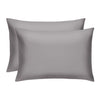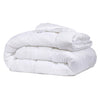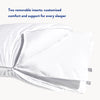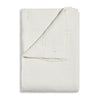The Daily Miracle
The Ultimate Guide On How To Wash Blankets
Published
September 14, 2022
Author
Bridget Reed

Not all blankets are created equal — fabric type, thread count, and material thickness can affect their wash protocol. With the cooler months quickly approaching, you may have started taking all your favorite fleeces out of storage.
While these beloved blankets haven’t been used in months, that’s not to say they don’t require a good wash (or two) — they’ve spent their downtime sitting, losing all the fluff you love, even if you stored them correctly.
The last way you want to welcome pumpkin spice and everything nice is with a stuffy nose and allergies galore. Instead, let’s talk about all things blankets and bedding and how to get your home clean and cozy for the winter months.
How To Wash Blankets
Not all blankets are the same — the best wash cycle depends on the type of blanket in question. Yes, you can toss them in the wash most of the time, but some blankets require a little more TLC.
Whether you’re planning on washing a family heirloom or a vintage throw you snagged on clearance, we have a guide to follow.
How To Hand Wash Your Blanket
Hand washing anything can seem daunting, but it's necessary for some types of fabric. While it might feel like a pain at first, you surely won’t regret it once you’re snuggled in bed; book in hand with toes toasty under the covers.
Are you worried that machine washing at home or the laundromat might ruin your favorite blanket? The good news is that you don’t have to just get by with spot cleaning or shell out for professional dry cleaning.
Refer to this hand washing method instead:
- Combine cold water and laundry detergent in a bin. Then, add in the blanket.
- Knead the fabric in the water and mild detergent solution until well covered.
- Once the fabric has been adequately washed, remove the blanket and allow excess to drain (do not wring out material.)
- Repeat the steps above with clean water (no detergent) until the fabric rinses completely clean (soap free).
- Next, gently press the wash out of the fabric. Placing the blanket between two dry towels may help speed up the process.
- After most of the water is removed from the blanket, hang up and allow the blanket to air dry.
How To Wash Fleece Blankets
There are eight commonly-seen types of fleece, but each variation can be further broken down into two categories — high-quality and low low-quality. Over time your blankets will show their true colors: In other words, you’ll know whether you purchased top-notch fleece or not.
If you got a not-so-hot fleece, you could expect the fabric to peel and lose its luxurious feel. However, high-quality fleece will remain intact and soft for a long while.
No matter what type of fleece you’re working with, this wash method will help prolong your blankets' lifetime.
- Wash the blanket with a high-quality bleach-free laundry detergent. Your detergent has much to do with how soft the blanket is after the wash. Ensure you’re using a detergent you trust.
- Run the washer with cool water on a gentle cycle.
- Add fabric softener mid-wash. Laundry detergent and fabric softener are not the same. You should add your softener during the rinse cycle. The ingredients used in fabric softeners are counteractive to the ingredients used in liquid detergent. You should always wait to add fabric softener until after the detergent is rinsed off.
- Air dry or tumble dry. We always suggest opting to air dry, but if you really must use your dryer, make sure it’s on a low heat setting and the gentlest spin cycle.
- Be cautious when it comes to using dryer balls and dryer sheets. Only use these add-ins on a case-by-case basis and when lint is a particular concern. These steps can help prevent pilling and preserve softness.
How To Wash Wool Blankets
Wool blankets can be tricky since sometimes they require an appointment at the dry-cleaners; refer to the label for care instructions.
Wool is notorious for shrinking, so we usually leave these washes to the professionals. But that’s not to say it’s impossible to do it correctly at home.
- Double check the care instructions on the label; if your blanket is machine washable, keep reading for delicate cycle instructions; if not, refer to the “hand washing” method above.
- Set your washing machine to a gentle cycle and use cold water rather than warm water.
- Allow it to spin for only one minute. Letting it spin for a minute will get just enough water out of the fabric without it stretching.
- Allow a few hours for the blanket to air dry. The harsh high heat setting on your drying machine could cause shrinkage, just like hot water can.
- For wool, you can also drape your blanket over a clothesline or a shower rod so that it dries in the right shape.
How To Wash Crochet Blankets
Crochet blankets are very different from any other blanket and should only be washed once per season. Since crochet blankets are usually handmade and much more delicate than the average blanket, you want to do everything possible to preserve their softness.
As for washing instructions, always hand wash your crochet items. Our hand washing method should work wonders on any of your crochet blankets this season.
How To Wash Comforters and Duvet Covers
Yes, your throw blankets are held near and dear, but what about your other bedding?
Whether you’re a comforter-cuddler or you feel that duvets do the trick, there is no better feeling than snuggling up in freshly washed bedding. Of course, comforters and duvets will require different steps than an average throw blanket, but we’re here to walk you through it.
Duvets
Duvets and comforters are different, and so is their required wash protocol (which also differs from the directions for bed sheets and pillowcases).
Duvets consist of two pieces that can detach and reattach, but comforters are just one. The best way to wash your duvet is by removing the cover first, and it should be washed on a gentle, cold wash cycle.
Comforters
Even though comforters can be a bit bulkier, it doesn't mean they’re more challenging to wash. The plus side of having a comforter is that they don’t require any particular type of wash cycle — gentle and cold will work just fine.
Just make sure you allow plenty of time in the dryer. It should be dried in a low-heat setting so that it may take more than one run-through.
How Often Should You Wash Your Blankets and Bedding?
Now that you know how to wash your blankets and other bedding, let’s talk about how often you should send your garments to the washroom.
It can be tough to decide on when to wash throw blankets as multiple household members (or pets) may be using them. If you’re only using your throws once or twice a week, you likely don’t need to wash them once a week.
As for your bedding, you should be washing it at least once a week. Unless you’re using silver-infused antibacterial bedding. Miracle Made antibacterial bedding only needs to be washed twice a month or so, resulting in 3x fewer laundry loads thanks to the infused antimicrobial silver.
Cozy As Can Be
The fall and winter months are no joke; you want to be prepared to be as cozy as possible whenever you’re home. The first step to ensuring your extremities are never left out to chill is by getting all your blankets, throws, and fleeces ready.
They’ve been sitting in storage for the last few months, itching to be brought down and returned to work. Before anything, they must go through a good washing. Luckily, now you know all the tricks (regardless of what type of blanket you’re dealing with.)
Sources:
Almost 300 years without a duvet | BBC News
How Do Fabric Softeners Work? | Scienceabc
Different Types of Fleece: Blizzard vs Anti-pill vs Polar | Sewingiscool
Storing Blankets and Pillows for Long-term Storage | SF Gate
Do clothes always shrink if you wash in warm water? | HowStuffWorks
How to Wash Bed Sheets for the Coziest Sleep Possible | Better Homes and Gardens


























